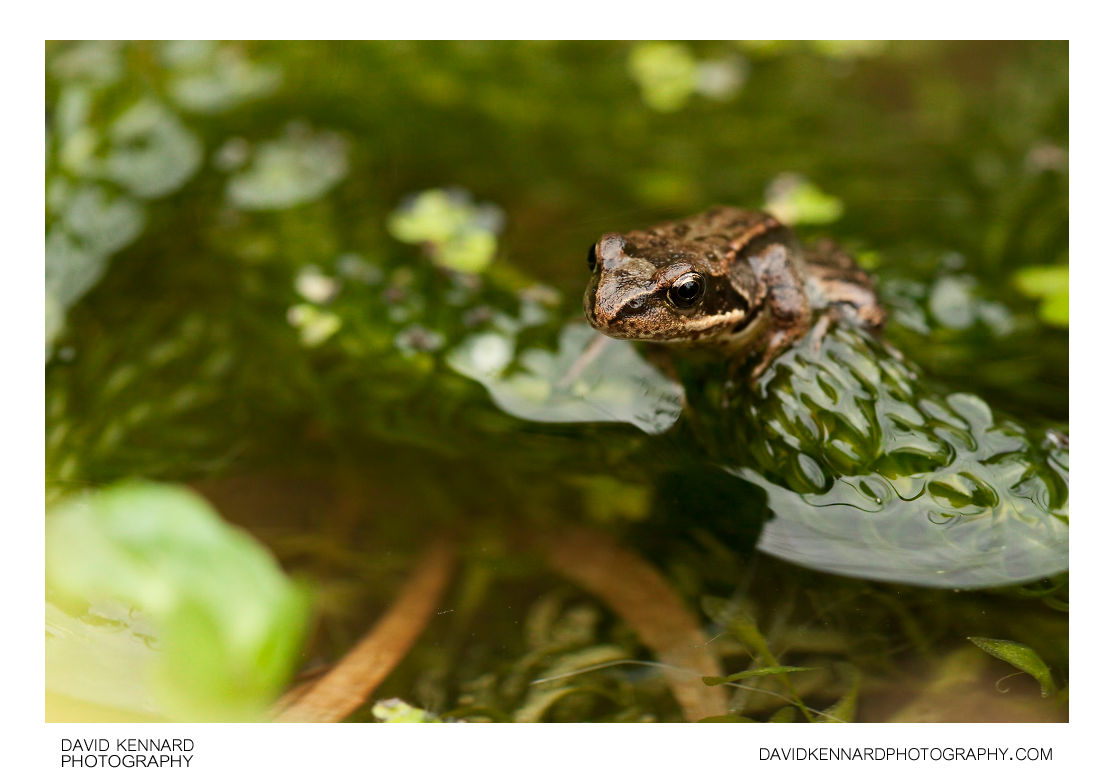Common Frog (Rana temporaria)

Description
- Title:
- Common Frog (Rana temporaria)
- Caption / Description:
-
The Common Frog, Rana temporaria also known as the European Common Frog or European Common Brown Frog is found throughout much of Europe as far north as well north of the Arctic Circle in Scandinavia and as far east as the Urals, except for most of Iberia, southern Italy, and the southern Balkans. The farthest west it can be found is Ireland, where it has long been thought erroneously to be an entirely introduced species.
Adult Common Frogs have a body length of between six and nine centimetres and their backs and flanks vary in colour, with olive green grey-brown, brown, olive-brown, grey, yellowish or rufous possible. However, Common Frogs are known to be able to lighten and darken their skin in order to match their surroundings. It is also not unknown for more unusual colouration- both black and red individuals have been found in Scotland, and male Common Frogs have been known to turn greyish blue in the mating season (video on page). Additionally, albino Common Frogs have been found with yellow skin and red eyes.
Common Frogs' flanks, limbs and backs are covered with irregular dark blotches and they usually sport a chevron-shaped spot on the back of their neck. Unlike other amphibians, Common Frogs generally lack a middorsal band, and when they have one, it is comparatively faint. In many countries the moor frogs do have a light dorsal band which easily distinguishes them from common frogs.
The frogs' underbellies are white or yellow (occasionally more orange in females) and can be speckled with brown or orange. Common Frogs have relatively short hind legs and possess webbed feet. The legs of the agile frog are much longer which distinguishes them from common frogs along with the agile frogs fainter colouration. Their eyes are brown with transparent horizontal pupils, and they have transparent inner eyelids to protect their eyes while underwater, as well as a 'mask' which covers their eyes and eardrums.
Males are distinguishable from females due to hard swellings (called nuptial pads) on their first finger. These are used for gripping females during mating. Also, during the mating season, males' throats often turn white. A final differentiation can be the colour- during the mating season, males are generally light and greyish in colour, whereas the female is browner, or even red. The intensity of the male coloration depends on the size of the choir present. A few specimen in a garden pond will not show much discoloration.
The mating season is short, just a week in March after which the frogs move back to their terrestrial habitat.
Description taken from Wikipedia: http://en.wikipedia.org/wiki/Common_Frog
- Tags / Keywords:
-
- Biota
- Life
- Vitae
- Eukaryota
- Animalia
- Animals
- Chordata
- Chordates
- Pond
- Amphibia
- Amphibians
- Anura
- Ranidae
- Rana
- Rana temporaria
- European frog
- Common Frog
Admin
- Date Original Photo Taken:
- Original File Name:
- _MG_5182.CR2
- Event:
- Rating:
- ☆
- Date this image added/last updated on website:
- Original File Dimensions:
- 4272px x 2848px
- File Type:
- JPEG
- Color Mode:
- RGB
- Original Image Color Profile:
- Adobe RGB (1998)
Location
- Location Created:
-
- Sublocation:
- City:
- Market Harborough
- Province/State:
- Leicestershire
- Country:
- United Kingdom
- World Region:
- Europe
- Geo-location:
Rights
- Copyright Status:
- Copyrighted
- Licensing Status:
- Rights Managed
- Available for Editorial Use:
- Yes
- Available for Commercial Use:
- Yes
- Copyright Notice:
- © 2010 Dave Kennard
Camera Data
- Date Digital Resource was created:
- Shutter speed:
- 1⁄200 s
- Aperture:
- f/5.6
- Camera Model:
- Canon EOS 450D
- ISO:
- 1600
- Exposure Compensation:
- 0
- Focal Length:
- 100mm
- Focal Length (35mm equiv.):
- Metering Mode:
- Multi-segment
- Flash:
- Off, Did not fire
- Exposure Mode:
- Manual
- White Balance:
- Manual
- Light Source:
- Exposure Program:
- Manual
Additional shooting metadata
- Lens:
- Canon EF 100mm F2.8 Macro USM
- Filters used:
- Additional Optics used:
- Setup:
- Handheld
Natural light ISO 1600
Post Processing
- Image Modified:
- Software used:
-
- Adobe Camera RAW
- Adobe Photoshop CS5
- Post Processing:
+0.45 exposure compensation in ACR
Topaz Denoise 5 with RAW moderate preset applied in PS CS5
Couple of bits of dirt removed from pond using spot healing brush in PS CS5
Curves adjustment in PS CS5 to increase contrast
